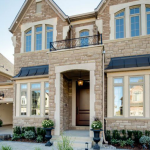For many years working to connect both the environment and development has become a major concern worldwide. The growing risks associated with a lack of sustainable development and continuous environmental change include human health risks, biodiversity changes, and the
decreasing supply of natural resources. There are many measures a homeowner can take to ensure their home is more environmentally friendly, such as renewing appliances, sealing cracks, and installing new windows. Here are 7 ways you can make your home more environmentally friendly:
-
Insulate Cavity Walls and Attics Properly
The majority of new homes are meticulously built, with strategically insulated attics using a high-efficiency cellulose insulation. However, if your home is older there may be some walls that are hollow and do not have proper insulation. These are called cavity walls, and they are a major contributor to energy loss. Cavity walls allow heat to pass directly through the wall, up into the attic and out of the house. In order to prevent significant energy consumption, ensure that any cavity walls, as well as attics, are properly insulated.
-
Install High End Storm Doors and Windows
Although a wooden front door emanates an inviting charm, wood is not ideal for a Canadian climate. Wooden doors expand and contract with heat and cold, causing energy loss. Many new homes are equipped with fibreglass storm doors and wooden frames, ensuring a perfect seal. Energy efficient windows combined with weather stripping or caulking are designed to withstand major temperature fluctuations and are commonly found in new homes. To make an older home more efficient, replace the front door with similar materials, and recaulk older windows.
-
Purchase Energy Star Appliances
Old appliances that are less energy efficient significantly contribute to energy loss and increased costs. Some new homes are eco-friendly right from the beginning, because they offer energy star appliances in the standard package. If this is not a part of the standard package, energy star appliances are also often available as a part of the upgrade from the builder. If your home is not already eco-friendly, reduce the costs of your energy bills and replace any old appliances with energy star appliances.
-
Replace Incandescent Light Bulbs
According to Hydro One, replacing the 5 most frequently used light bulbs in your house with energy efficient light bulbs can save you approximately $75.00-$100.00 per year in energy costs. New homes come equipped with energy efficient bulbs, but if your home is older, you may want to consider replacing some of yours.
-
Fix or Replace an Old Furnace
New homes come equipped with energy efficient furnaces. A high-efficiency furnace burns less gas, produces more heat, and reduces carbon emissions. If you are living in an older home, you can either opt to have an older furnace replaced or make your current furnace more efficient by changing air filters on a regular basis, adding a programmable thermostat and closing vents in rooms that you do not use frequently.
-
Wrap Old Water Heaters
Water heaters in today’s homes are designed to be on-demand, meaning the water is not being heated unless in use. However, older water heaters are based off of electricity and can cause high energy consumption. You can significantly reduce the amount of energy consumption by wrapping an old hot water heater with an eco-friendly foil insulation blanket. Taking this step will keep the water in the tank warmer for longer periods of time while reducing the amount of electricity your water heater uses.
-
Insulate Pipes
During the construction of a new home, pipes are installed and insulated immediately. However, most older homes are less likely to have well-insulated pipes, making them much less energy efficient. According to energy.gov, the average household contributes more than ¼ of energy costs to the final bill by heating water. Installing insulation around pipes will keep the water warmer longer, reducing your energy bill and making your home more eco-friendly.
Practicing eco-friendly measures within your home is not only beneficial to you and your family but for the environment as well.For more information on making your home more energy efficient, visit the Caliber Homes Blog.
